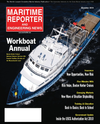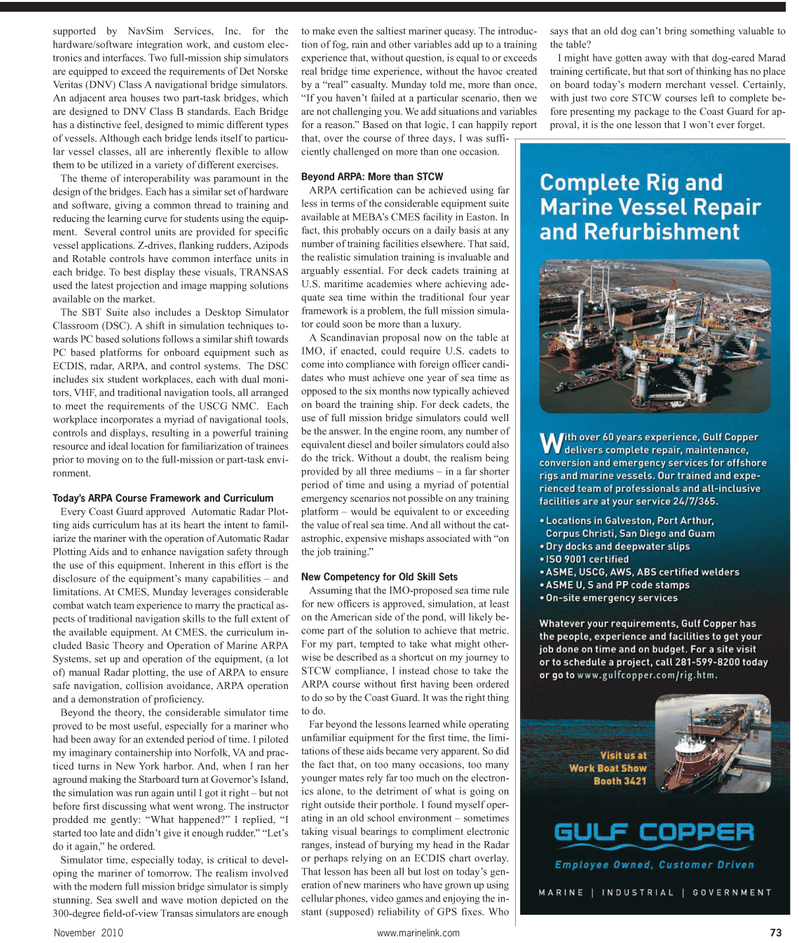
Page 75: of Maritime Reporter Magazine (November 2010)
Workboat Annual
Read this page in Pdf, Flash or Html5 edition of November 2010 Maritime Reporter Magazine
November 2010 www.marinelink.com 73 supported by NavSim Services, Inc. for the hardware/software integration work, and custom elec- tronics and interfaces. Two full-mission ship simulators are equipped to exceed the requirements of Det Norske
Veritas (DNV) Class A navigational bridge simulators.
An adjacent area houses two part-task bridges, which are designed to DNV Class B standards. Each Bridge has a distinctive feel, designed to mimic different types of vessels. Although each bridge lends itself to particu- lar vessel classes, all are inherently flexible to allow them to be utilized in a variety of different exercises.
The theme of interoperability was paramount in the design of the bridges. Each has a similar set of hardware and software, giving a common thread to training and reducing the learning curve for students using the equip- ment. Several control units are provided for specific vessel applications. Z-drives, flanking rudders, Azipods and Rotable controls have common interface units in each bridge. To best display these visuals, TRANSAS used the latest projection and image mapping solutions available on the market.
The SBT Suite also includes a Desktop Simulator
Classroom (DSC). A shift in simulation techniques to- wards PC based solutions follows a similar shift towards
PC based platforms for onboard equipment such as
ECDIS, radar, ARPA, and control systems. The DSC includes six student workplaces, each with dual moni- tors, VHF, and traditional navigation tools, all arranged to meet the requirements of the USCG NMC. Each workplace incorporates a myriad of navigational tools, controls and displays, resulting in a powerful training resource and ideal location for familiarization of trainees prior to moving on to the full-mission or part-task envi- ronment.
Today’s ARPA Course Framework and Curriculum
Every Coast Guard approved Automatic Radar Plot- ting aids curriculum has at its heart the intent to famil- iarize the mariner with the operation of Automatic Radar
Plotting Aids and to enhance navigation safety through the use of this equipment. Inherent in this effort is the disclosure of the equipment’s many capabilities – and limitations. At CMES, Munday leverages considerable combat watch team experience to marry the practical as- pects of traditional navigation skills to the full extent of the available equipment. At CMES, the curriculum in- cluded Basic Theory and Operation of Marine ARPA
Systems, set up and operation of the equipment, (a lot of) manual Radar plotting, the use of ARPA to ensure safe navigation, collision avoidance, ARPA operation and a demonstration of proficiency.
Beyond the theory, the considerable simulator time proved to be most useful, especially for a mariner who had been away for an extended period of time. I piloted my imaginary containership into Norfolk, VA and prac- ticed turns in New York harbor. And, when I ran her aground making the Starboard turn at Governor’s Island, the simulation was run again until I got it right – but not before first discussing what went wrong. The instructor prodded me gently: “What happened?” I replied, “I started too late and didn’t give it enough rudder.” “Let’s do it again,” he ordered.
Simulator time, especially today, is critical to devel- oping the mariner of tomorrow. The realism involved with the modern full mission bridge simulator is simply stunning. Sea swell and wave motion depicted on the 300-degree field-of-view Transas simulators are enough to make even the saltiest mariner queasy. The introduc- tion of fog, rain and other variables add up to a training experience that, without question, is equal to or exceeds real bridge time experience, without the havoc created by a “real” casualty. Munday told me, more than once, “If you haven’t failed at a particular scenario, then we are not challenging you. We add situations and variables for a reason.” Based on that logic, I can happily report that, over the course of three days, I was suffi- ciently challenged on more than one occasion.
Beyond ARPA: More than STCW
ARPA certification can be achieved using far less in terms of the considerable equipment suite available at MEBA’s CMES facility in Easton. In fact, this probably occurs on a daily basis at any number of training facilities elsewhere. That said, the realistic simulation training is invaluable and arguably essential. For deck cadets training at
U.S. maritime academies where achieving ade- quate sea time within the traditional four year framework is a problem, the full mission simula- tor could soon be more than a luxury.
A Scandinavian proposal now on the table at
IMO, if enacted, could require U.S. cadets to come into compliance with foreign officer candi- dates who must achieve one year of sea time as opposed to the six months now typically achieved on board the training ship. For deck cadets, the use of full mission bridge simulators could well be the answer. In the engine room, any number of equivalent diesel and boiler simulators could also do the trick. Without a doubt, the realism being provided by all three mediums – in a far shorter period of time and using a myriad of potential emergency scenarios not possible on any training platform – would be equivalent to or exceeding the value of real sea time. And all without the cat- astrophic, expensive mishaps associated with “on the job training.”
New Competency for Old Skill Sets
Assuming that the IMO-proposed sea time rule for new officers is approved, simulation, at least on the American side of the pond, will likely be- come part of the solution to achieve that metric.
For my part, tempted to take what might other- wise be described as a shortcut on my journey to
STCW compliance, I instead chose to take the
ARPA course without first having been ordered to do so by the Coast Guard. It was the right thing to do.
Far beyond the lessons learned while operating unfamiliar equipment for the first time, the limi- tations of these aids became very apparent. So did the fact that, on too many occasions, too many younger mates rely far too much on the electron- ics alone, to the detriment of what is going on right outside their porthole. I found myself oper- ating in an old school environment – sometimes taking visual bearings to compliment electronic ranges, instead of burying my head in the Radar or perhaps relying on an ECDIS chart overlay.
That lesson has been all but lost on today’s gen- eration of new mariners who have grown up using cellular phones, video games and enjoying the in- stant (supposed) reliability of GPS fixes. Who says that an old dog can’t bring something valuable to the table?
I might have gotten away with that dog-eared Marad training certificate, but that sort of thinking has no place on board today’s modern merchant vessel. Certainly, with just two core STCW courses left to complete be- fore presenting my package to the Coast Guard for ap- proval, it is the one lesson that I won’t ever forget.

 74
74

 76
76
